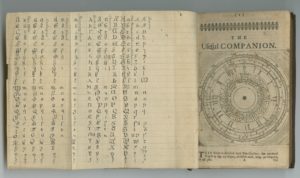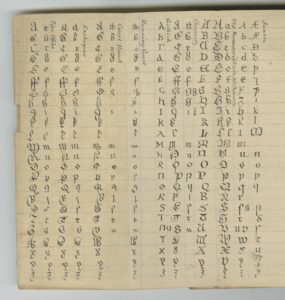Swem Library holds two editions of A grammar of the English tongue, with the arts of logick, rhetoric, poetry, &c., but it is in the earlier one, printed in 1714, that we find something unexpected and extraordinary. This volume belonged to Samuel Clark, who, according to Alumni Oxonienses by J. Foster, matriculated at St. John’s College, Oxford in 1725 at age 18, graduated BA in 1729, MA in 1733, and BD in 1738. That he was a fellow of the college we know only because he told us so with his autograph on the flyleaf: Sam:[ue]ll Clark e Coll:[egium] Di:[vi] Jo:[annis] Bap:[tisti] Soc:[ius] Oxon.[ienses].
 A grammar of the English tongue, with
A grammar of the English tongue, with
the arts of logick, rhetoric, poetry, &c.
On the verso of the flyleaf appear two columns of manuscript letters in what this cataloguer took to be a Gothic alphabet, but soon all would be made clear, as on further examination of the book, a remarkable artifact of Mr. Clark’s infatuation with the written word appeared: Tipped in following the preface was a manuscript chart of alphabets in use from the middle ages through the Renaissance! Ruled in pencil and filled in with careful ink strokes, Clark transcribed examples of several hands, mostly used by government scribes. Paleography is always a puzzle because of the individuality of writers. Those who study ancient forms of handwriting can never have enough examples, and evidently Samuel Clark was attempting to record the best cheat sheet for his time. As such, it is of great value to the 21st-century researcher and cataloguer. (For the curious, his practice alphabet, completed only through the letter “h,” was taken from the Exchequer hand.)
 Detail of Clark's chart
Detail of Clark's chart
Written by Ellen Cloyed, Serials and Rare Books Cataloguer